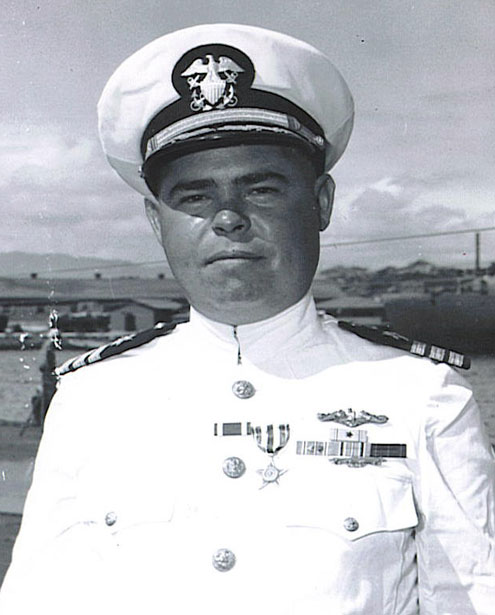Hispanic Heritage Month is September 15-October 15, a time to recognize contributions to our country by Hispanic Americans. Navy Day, October 27, honors all military personnel who served in the United States Navy. Here is an homage to Marion Frederic Ramirez de Arellano, an intrepid submarine commander of World War II.
Captain Arellano was said to be the youngest submarine commander in World War II – but he was definitely the first Hispanic to hold that position. Born in San Juan in 1913 to an educated family (both his parents became professors at the University of Puerto Rico), Arellano was appointed in 1931 to the Naval Academy. He excelled in sports and languages and held positions in the pistol club and the electronics clique before receiving his commission in 1935.
Arellano’s first Naval assignment was as a Gunnery Officer aboard the USS Ranger, the first ship designed as an aircraft carrier. After proving his expertise, he was accepted to attend the Submarine School at Groton, Connecticut. World War II began soon after graduation.
The day after the attack on Pearl Harbor, Arellano’s submarine was attacked by the Japanese in the Philippines. The USS Pickerel returned fire. On their second patrol, his ship sank the Kanko Maru, a Japanese vessel. On subsequent patrols, the Pickerel sank two enemy freighters, damaged a third, and rescued a Navy flight crew.
His second submarine assignment was aboard the USS Skate. Arellano received a Silver Star for his contributions in sinking the Japanese light cruiser Agano. By 1944, he became Commanding Officer of the submarine USS Balao. His rescue of another crew of Navy pilots and the sinking of more Japanese ships merited a Bronze Star and a Letter of Commendation.
Life aboard a wartime submarine was dirty and dangerous. Crew members would sometimes complain there was not enough oxygen to light a cigarette. Stale tobacco smoke would mix with the stench of diesel fumes, sweat, and sewage in the cramped quarters. And the deplorable conditions were only matched by the hazards of combat. About one in five submarines were sunk during the war.
At war’s end, Arellano became the commanding officer of the Submarine Base at Saint Thomas, U.S. Virgin Islands. Later he served as commander of the USS Lindenwald and the USS Thomaston. Arellano also held various administrative and teaching positions in Madrid, Annapolis, and Washington, D.C., before retiring in 1961.

Along the way, he married Mysie Isabel Judson Taggart and became the father of three sons. Arellano spent parts of his life in San Juan, Puerto Rico; Guanajuato, Mexico; San Antonio, Texas; and all points in between.
Captain Arellano usually had a smile on his face; the kind of smile that leads one to think he is up to something. And he usually had a twinkle in his eye, the kind that gives a man the impression he is a co-conspirator.
Examples of his humor can be found in his notes as commander of the USS Balao during WWII. As dangerous and harrowing as engagements with the Japanese were, Arellano filed this report:
“A grim battle was waged throughout the patrol between the crew and cockroaches. At many times, the decision was in doubt, especially when copra bugs (from the enemy sampan loot) reinforced the roaches.” – Capt. Arellano
The captain’s humor was infectious – and he included it in his reports. After the rescue of Air Group Commander Mark Grant, Arellano recorded the words of the commander as he departed his life raft: “Dr. Livingston, I presume?” Arellano further reported Grant’s lamentation that he left his ‘prized false teeth’ on the raft.
Continuing his mid-battle comedy routine, Arellano wrote that Grant held up his canteen and quipped, “How are you fixed for water?”
No doubt, Captain Arellano smiled broadly, offered his hand, and exclaimed, “Welcome aboard!”
Not content to let the flyboys see all the action, Arellano once surfaced his sub during an engagement to bombard shore targets with the deck gun. After scoring direct hits on a lighthouse and a phosphate loading dock, he reported that he “started a merry blaze.”
Torpedoes fired from WWII submarines were notoriously poor for hitting their targets. During the USS Balao engagement with the Japanese Daigo Maru, only six of 15 torpedoes hit their mark – but it still remained afloat.
“This ship must be loaded with ping-pong balls,” Arellano recalled, “or else our torpedoes are loaded with avocet” (a species of shorebird). Finally, the 16th torpedo resulted in sinking the cargo ship. The captain reported the radar operator’s observation, “He’s going, going and gone.”
While patrolling a few days later, the USS Balao sighted an object assumed to be an enemy ship, but upon drawing near, was determined to be the USS Spot. Arellano wrote in his report that he “decided it wasn’t good to scare the Group Commander, (he’s bigger than I am), so withdrew quietly.”
Arellano’s humor – and his esprit de corps – never left him.
After a major stroke in 1980 at his home in Washington, D.C., a cab driver was going to take the old sea captain to the hospital at Andrews AFB. "No," he insisted, "That's Air Force. Take me to Bethesda Naval Hospital" (about 30 miles more distant).
Arellano died along the way, but he died the way he wanted – headstrong and with a sense of humor. The cab driver turned back to Andrews AFB where Arellano was pronounced dead. The captain was buried with honors at Arlington National Cemetery.
Here's to Capt. Marion Frederic Ramírez de Arellano, a member of America’s greatest generation and our nation’s first submarine commander of Hispanic heritage. Salute!


